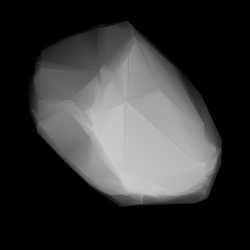3728 IRAS, provisional designation 1983 QF, is a stony asteroid from the middle region of the asteroid belt, approximately 20 kilometers in diameter. On 23 August 1983, it was discovered by and later named after IRAS, a spaceborne all-sky infrared survey satellite.
1810 Epimetheus, provisional designation 4196 P-L, is a stony Florian asteroid from the inner regions of the asteroid belt, approximately 8 kilometers in diameter.
6433 Enya, provisional designation 1978 WC, is a stony background asteroid from the inner regions of the asteroid belt, approximately 7 kilometers in diameter. It was discovered on 18 November 1978, by Czech astronomer Antonín Mrkos at the Kleť Observatory in the Czech Republic. It was named for Irish musician Enya.

9903 Leonhardt, provisional designation 1997 NA1, is a dark asteroid from the outer region of the asteroid belt, approximately 10 kilometers in diameter.

1118 Hanskya is a large background asteroid, approximately 77 kilometers in diameter, located in the outer regions of the asteroid belt. Discovered by Sergey Belyavsky and Nikolaj Ivanov in 1927, it was named after Russian astronomer Aleksey Hansky. The presumed dark C-type asteroid has a rotation period of 15.6 hours.
2906 Caltech, provisional designation 1983 AE2, is an asteroid from the outer region of the asteroid belt, approximately 56 kilometers in diameter. It was discovered on 13 January 1983 by American astronomer Carolyn Shoemaker at Palomar Observatory in the United States. It is named after the California Institute of Technology.
2153 Akiyama, provisional designation 1978 XD, is a carbonaceous Themistian asteroid from the outer region of the asteroid belt, approximately 17 kilometers in diameter.
1617 Alschmitt, provisional designation 1952 FB, is an assumed carbonaceous asteroid from in the outer parts of the main belt, approximately 30 kilometers in diameter. It was discovered on 20 March 1952, by French astronomer Louis Boyer at Algiers Observatory in Algeria, Northern Africa, and named after French astronomer Alfred Schmitt.
1879 Broederstroom, provisional designation 1935 UN, is a stony Florian asteroid from the inner regions of the asteroid belt, approximately 7 kilometers in diameter. It was discovered on 16 October 1935, by Dutch astronomer Hendrik van Gent at the Leiden Southern Station, annex to the Johannesburg Observatory in South Africa. The asteroid was named after the South African village of Broederstroom.
2442 Corbett, provisional designation 1980 TO, is a vestoid asteroid from the inner regions of the asteroid belt, approximately 8.5 kilometers in diameter. It was discovered on 3 October 1980, by Czech astronomer Zdeňka Vávrová at Kleť Observatory, now in the Czech Republic. It is named after British-Indian hunter Jim Corbett.
5316 Filatov, provisional designation 1982 UB7, is a carbonaceous asteroid and potentially slow rotator from the outer region of the asteroid belt, approximately 30 kilometers in diameter.
3425 Hurukawa, provisional designation 1929 BD, is a stony Eoan asteroid from the outer region of the asteroid belt, approximately 25 kilometers in diameter. It was discovered by German astronomer Karl Reinmuth at Heidelberg Observatory on 29 January 1929, and named after Japanese astronomer Kiichirō Furukawa.
4822 Karge, provisional designation 1986 TC1, is a bright asteroid from the inner regions of the asteroid belt, approximately 4 kilometers in diameter. It was discovered on 4 October 1986, by American astronomer Edward Bowell at the Anderson Mesa Station of the Lowell Observatory in Flagstaff, Arizona. The asteroid was later named after American physics teacher Orville Karge.
1690 Mayrhofer, provisional designation 1948 VB, is a carbonaceous asteroid from the outer region of the asteroid belt, approximately 32 kilometers in diameter. It was discovered on 8 November 1948, by French astronomer Marguerite Laugier at Nice Observatory in south-east France. It was later named after Austrian amateur astronomer Karl Mayrhofer.
11118 Modra is a Flora asteroid of uncertain composition from the inner regions of the asteroid belt, approximately 5 kilometers in diameter.
1525 Savonlinna, provisional designation 1939 SC, is an asteroid from the central region of the asteroid belt, approximately 12 kilometers in diameter. It was discovered on 18 September 1939, by Finnish astronomer Yrjö Väisälä at the Turku Observatory in southwestern Finland. It was later named after the eastern Finnish town Savonlinna.
3133 Sendai, provisional designation A907 TC, is a stony Flora asteroid from the inner regions of the asteroid belt, approximately 8 kilometers in diameter. It was discovered on 4 October 1907, by German astronomer August Kopff at Heidelberg Observatory in southwest Germany. The asteroid was named for the Japanese city of Sendai.
4082 Swann, provisional designation 1984 SW3, is a carbonaceous asteroid from the inner regions of the asteroid belt, approximately 10 kilometers in diameter.
9321 Alexkonopliv, provisional designation 1989 AK, is a carbonaceous background asteroid from the outer region of the asteroid belt, approximately 11 kilometers in diameter.
24988 Alainmilsztajn (provisional designation 1998 MM2) is a background asteroid from the inner regions of the asteroid belt, approximately 2.5 kilometers in diameter. It was discovered on 19 June 1998, by the OCA–DLR Asteroid Survey at CERGA, Caussols, in southeastern France. The asteroid was named after French particle physicist Alain Milsztajn.


